Can we win war against terrorism?
VerifiedAdded on 2023/06/11
|12
|3459
|170
AI Summary
This article explores the various methods used by governments to fight terrorism, their effectiveness, and the best tactics that can be used to effectively win the war against terrorism. It analyzes the current tactics used by governments to fight terrorism, including combating financing of terrorism, taking down terrorist websites, monitoring potential terrorists, punishing terrorists, and increasing security in the country. The article also discusses the best tactics to tackle terrorism, including reconciliation, building resilience, counter-terrorism, and working with partners. Finally, it suggests other tactics to tackle terrorism, such as providing education, creating employment, and recruiting more security personnel.
Contribute Materials
Your contribution can guide someone’s learning journey. Share your
documents today.
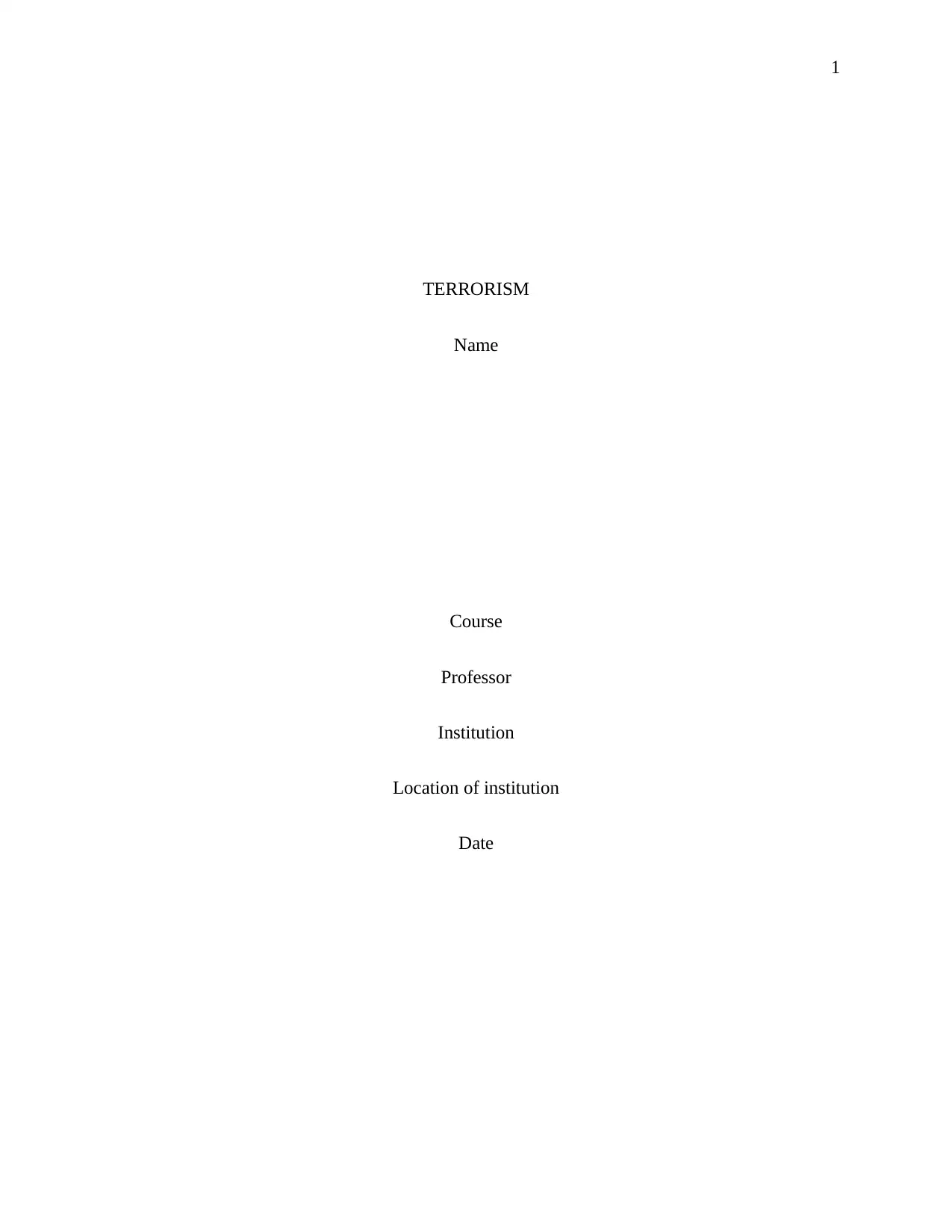
1
TERRORISM
Name
Course
Professor
Institution
Location of institution
Date
TERRORISM
Name
Course
Professor
Institution
Location of institution
Date
Secure Best Marks with AI Grader
Need help grading? Try our AI Grader for instant feedback on your assignments.
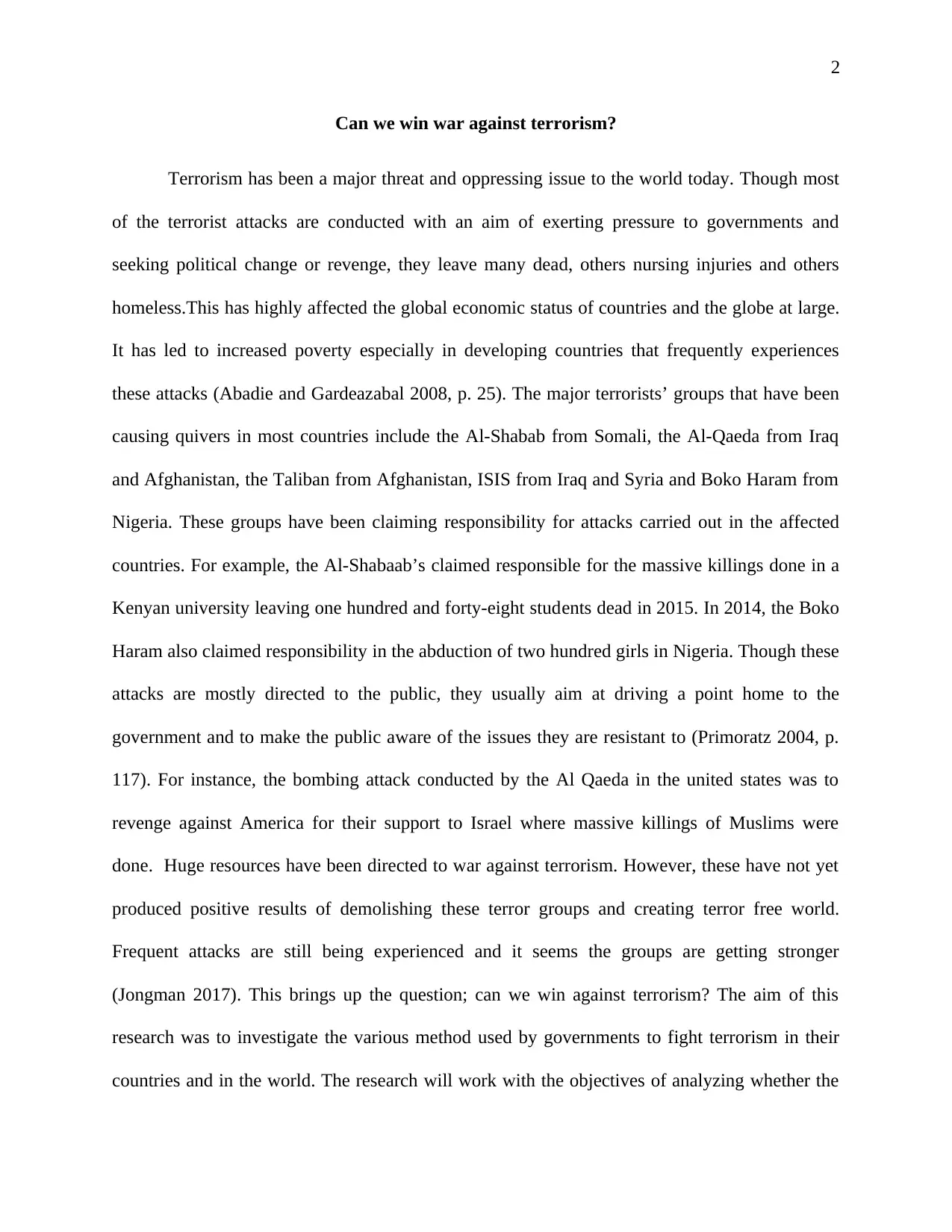
2
Can we win war against terrorism?
Terrorism has been a major threat and oppressing issue to the world today. Though most
of the terrorist attacks are conducted with an aim of exerting pressure to governments and
seeking political change or revenge, they leave many dead, others nursing injuries and others
homeless.This has highly affected the global economic status of countries and the globe at large.
It has led to increased poverty especially in developing countries that frequently experiences
these attacks (Abadie and Gardeazabal 2008, p. 25). The major terrorists’ groups that have been
causing quivers in most countries include the Al-Shabab from Somali, the Al-Qaeda from Iraq
and Afghanistan, the Taliban from Afghanistan, ISIS from Iraq and Syria and Boko Haram from
Nigeria. These groups have been claiming responsibility for attacks carried out in the affected
countries. For example, the Al-Shabaab’s claimed responsible for the massive killings done in a
Kenyan university leaving one hundred and forty-eight students dead in 2015. In 2014, the Boko
Haram also claimed responsibility in the abduction of two hundred girls in Nigeria. Though these
attacks are mostly directed to the public, they usually aim at driving a point home to the
government and to make the public aware of the issues they are resistant to (Primoratz 2004, p.
117). For instance, the bombing attack conducted by the Al Qaeda in the united states was to
revenge against America for their support to Israel where massive killings of Muslims were
done. Huge resources have been directed to war against terrorism. However, these have not yet
produced positive results of demolishing these terror groups and creating terror free world.
Frequent attacks are still being experienced and it seems the groups are getting stronger
(Jongman 2017). This brings up the question; can we win against terrorism? The aim of this
research was to investigate the various method used by governments to fight terrorism in their
countries and in the world. The research will work with the objectives of analyzing whether the
Can we win war against terrorism?
Terrorism has been a major threat and oppressing issue to the world today. Though most
of the terrorist attacks are conducted with an aim of exerting pressure to governments and
seeking political change or revenge, they leave many dead, others nursing injuries and others
homeless.This has highly affected the global economic status of countries and the globe at large.
It has led to increased poverty especially in developing countries that frequently experiences
these attacks (Abadie and Gardeazabal 2008, p. 25). The major terrorists’ groups that have been
causing quivers in most countries include the Al-Shabab from Somali, the Al-Qaeda from Iraq
and Afghanistan, the Taliban from Afghanistan, ISIS from Iraq and Syria and Boko Haram from
Nigeria. These groups have been claiming responsibility for attacks carried out in the affected
countries. For example, the Al-Shabaab’s claimed responsible for the massive killings done in a
Kenyan university leaving one hundred and forty-eight students dead in 2015. In 2014, the Boko
Haram also claimed responsibility in the abduction of two hundred girls in Nigeria. Though these
attacks are mostly directed to the public, they usually aim at driving a point home to the
government and to make the public aware of the issues they are resistant to (Primoratz 2004, p.
117). For instance, the bombing attack conducted by the Al Qaeda in the united states was to
revenge against America for their support to Israel where massive killings of Muslims were
done. Huge resources have been directed to war against terrorism. However, these have not yet
produced positive results of demolishing these terror groups and creating terror free world.
Frequent attacks are still being experienced and it seems the groups are getting stronger
(Jongman 2017). This brings up the question; can we win against terrorism? The aim of this
research was to investigate the various method used by governments to fight terrorism in their
countries and in the world. The research will work with the objectives of analyzing whether the
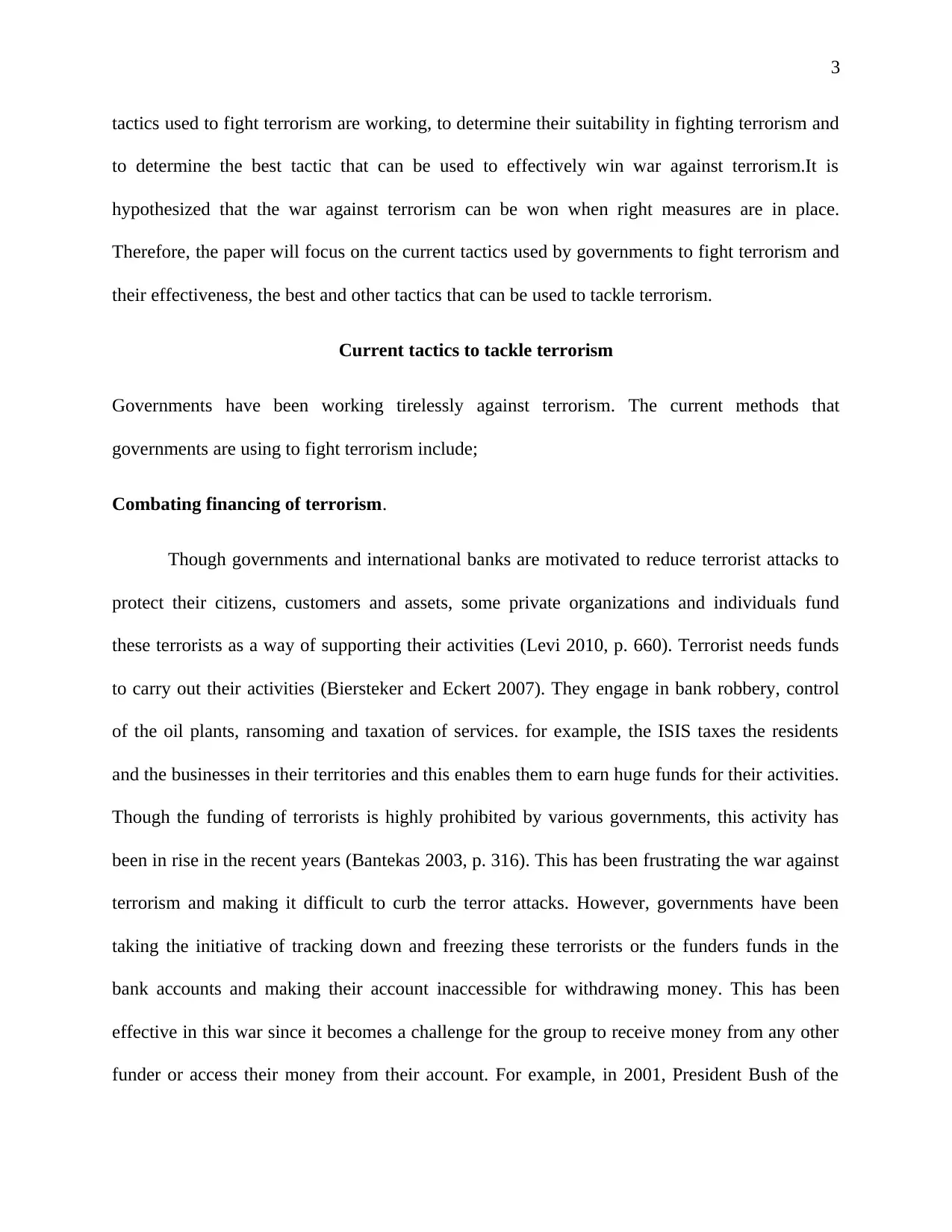
3
tactics used to fight terrorism are working, to determine their suitability in fighting terrorism and
to determine the best tactic that can be used to effectively win war against terrorism.It is
hypothesized that the war against terrorism can be won when right measures are in place.
Therefore, the paper will focus on the current tactics used by governments to fight terrorism and
their effectiveness, the best and other tactics that can be used to tackle terrorism.
Current tactics to tackle terrorism
Governments have been working tirelessly against terrorism. The current methods that
governments are using to fight terrorism include;
Combating financing of terrorism.
Though governments and international banks are motivated to reduce terrorist attacks to
protect their citizens, customers and assets, some private organizations and individuals fund
these terrorists as a way of supporting their activities (Levi 2010, p. 660). Terrorist needs funds
to carry out their activities (Biersteker and Eckert 2007). They engage in bank robbery, control
of the oil plants, ransoming and taxation of services. for example, the ISIS taxes the residents
and the businesses in their territories and this enables them to earn huge funds for their activities.
Though the funding of terrorists is highly prohibited by various governments, this activity has
been in rise in the recent years (Bantekas 2003, p. 316). This has been frustrating the war against
terrorism and making it difficult to curb the terror attacks. However, governments have been
taking the initiative of tracking down and freezing these terrorists or the funders funds in the
bank accounts and making their account inaccessible for withdrawing money. This has been
effective in this war since it becomes a challenge for the group to receive money from any other
funder or access their money from their account. For example, in 2001, President Bush of the
tactics used to fight terrorism are working, to determine their suitability in fighting terrorism and
to determine the best tactic that can be used to effectively win war against terrorism.It is
hypothesized that the war against terrorism can be won when right measures are in place.
Therefore, the paper will focus on the current tactics used by governments to fight terrorism and
their effectiveness, the best and other tactics that can be used to tackle terrorism.
Current tactics to tackle terrorism
Governments have been working tirelessly against terrorism. The current methods that
governments are using to fight terrorism include;
Combating financing of terrorism.
Though governments and international banks are motivated to reduce terrorist attacks to
protect their citizens, customers and assets, some private organizations and individuals fund
these terrorists as a way of supporting their activities (Levi 2010, p. 660). Terrorist needs funds
to carry out their activities (Biersteker and Eckert 2007). They engage in bank robbery, control
of the oil plants, ransoming and taxation of services. for example, the ISIS taxes the residents
and the businesses in their territories and this enables them to earn huge funds for their activities.
Though the funding of terrorists is highly prohibited by various governments, this activity has
been in rise in the recent years (Bantekas 2003, p. 316). This has been frustrating the war against
terrorism and making it difficult to curb the terror attacks. However, governments have been
taking the initiative of tracking down and freezing these terrorists or the funders funds in the
bank accounts and making their account inaccessible for withdrawing money. This has been
effective in this war since it becomes a challenge for the group to receive money from any other
funder or access their money from their account. For example, in 2001, President Bush of the
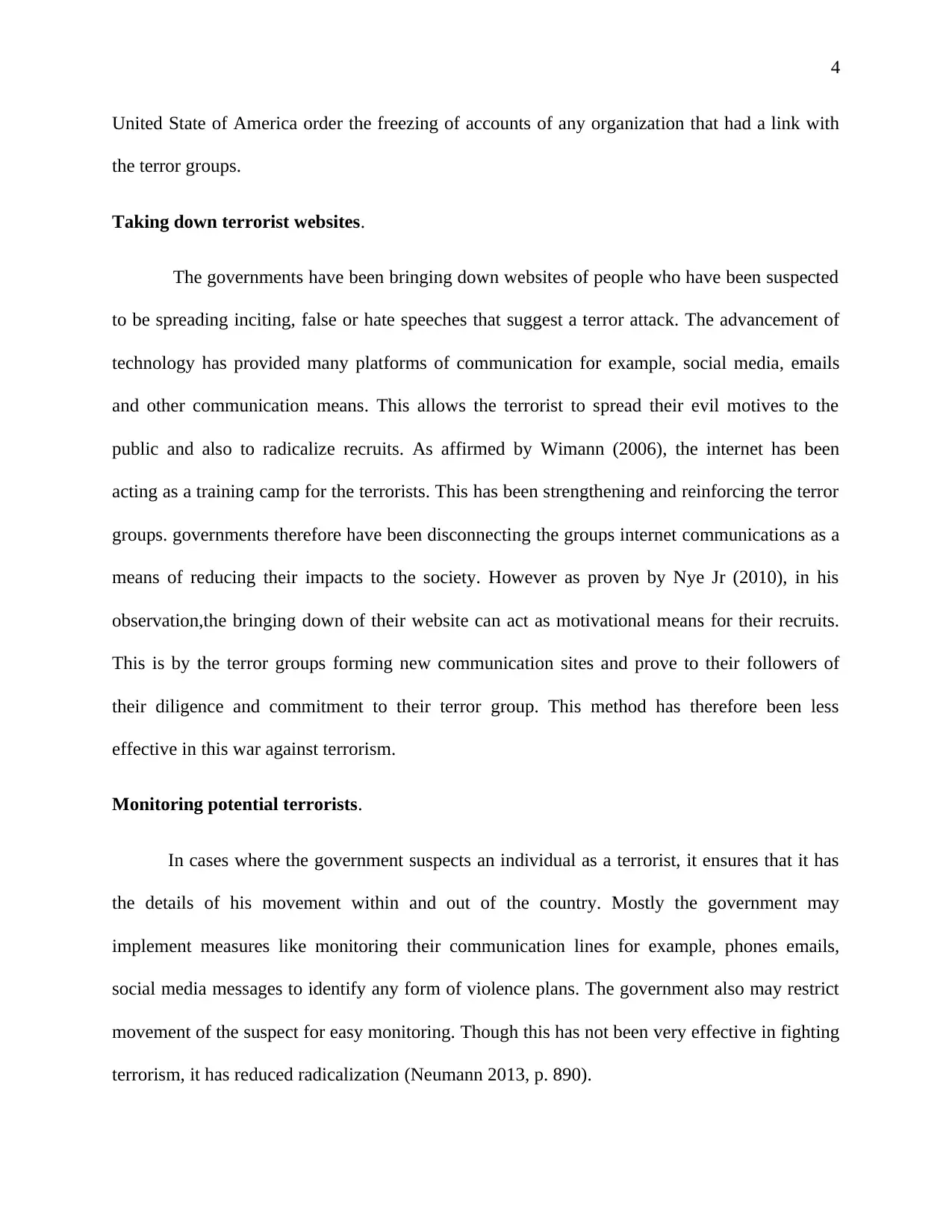
4
United State of America order the freezing of accounts of any organization that had a link with
the terror groups.
Taking down terrorist websites.
The governments have been bringing down websites of people who have been suspected
to be spreading inciting, false or hate speeches that suggest a terror attack. The advancement of
technology has provided many platforms of communication for example, social media, emails
and other communication means. This allows the terrorist to spread their evil motives to the
public and also to radicalize recruits. As affirmed by Wimann (2006), the internet has been
acting as a training camp for the terrorists. This has been strengthening and reinforcing the terror
groups. governments therefore have been disconnecting the groups internet communications as a
means of reducing their impacts to the society. However as proven by Nye Jr (2010), in his
observation,the bringing down of their website can act as motivational means for their recruits.
This is by the terror groups forming new communication sites and prove to their followers of
their diligence and commitment to their terror group. This method has therefore been less
effective in this war against terrorism.
Monitoring potential terrorists.
In cases where the government suspects an individual as a terrorist, it ensures that it has
the details of his movement within and out of the country. Mostly the government may
implement measures like monitoring their communication lines for example, phones emails,
social media messages to identify any form of violence plans. The government also may restrict
movement of the suspect for easy monitoring. Though this has not been very effective in fighting
terrorism, it has reduced radicalization (Neumann 2013, p. 890).
United State of America order the freezing of accounts of any organization that had a link with
the terror groups.
Taking down terrorist websites.
The governments have been bringing down websites of people who have been suspected
to be spreading inciting, false or hate speeches that suggest a terror attack. The advancement of
technology has provided many platforms of communication for example, social media, emails
and other communication means. This allows the terrorist to spread their evil motives to the
public and also to radicalize recruits. As affirmed by Wimann (2006), the internet has been
acting as a training camp for the terrorists. This has been strengthening and reinforcing the terror
groups. governments therefore have been disconnecting the groups internet communications as a
means of reducing their impacts to the society. However as proven by Nye Jr (2010), in his
observation,the bringing down of their website can act as motivational means for their recruits.
This is by the terror groups forming new communication sites and prove to their followers of
their diligence and commitment to their terror group. This method has therefore been less
effective in this war against terrorism.
Monitoring potential terrorists.
In cases where the government suspects an individual as a terrorist, it ensures that it has
the details of his movement within and out of the country. Mostly the government may
implement measures like monitoring their communication lines for example, phones emails,
social media messages to identify any form of violence plans. The government also may restrict
movement of the suspect for easy monitoring. Though this has not been very effective in fighting
terrorism, it has reduced radicalization (Neumann 2013, p. 890).
Secure Best Marks with AI Grader
Need help grading? Try our AI Grader for instant feedback on your assignments.
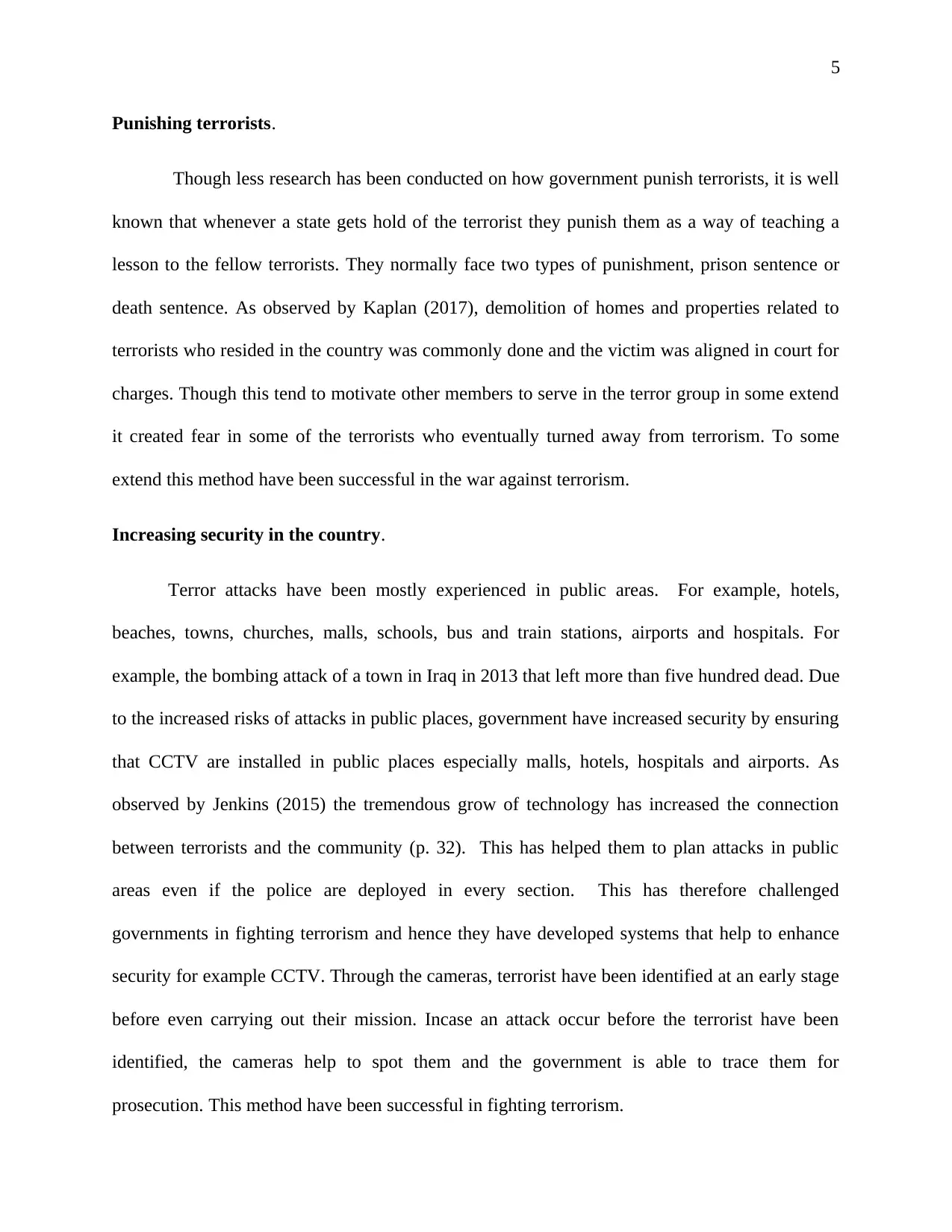
5
Punishing terrorists.
Though less research has been conducted on how government punish terrorists, it is well
known that whenever a state gets hold of the terrorist they punish them as a way of teaching a
lesson to the fellow terrorists. They normally face two types of punishment, prison sentence or
death sentence. As observed by Kaplan (2017), demolition of homes and properties related to
terrorists who resided in the country was commonly done and the victim was aligned in court for
charges. Though this tend to motivate other members to serve in the terror group in some extend
it created fear in some of the terrorists who eventually turned away from terrorism. To some
extend this method have been successful in the war against terrorism.
Increasing security in the country.
Terror attacks have been mostly experienced in public areas. For example, hotels,
beaches, towns, churches, malls, schools, bus and train stations, airports and hospitals. For
example, the bombing attack of a town in Iraq in 2013 that left more than five hundred dead. Due
to the increased risks of attacks in public places, government have increased security by ensuring
that CCTV are installed in public places especially malls, hotels, hospitals and airports. As
observed by Jenkins (2015) the tremendous grow of technology has increased the connection
between terrorists and the community (p. 32). This has helped them to plan attacks in public
areas even if the police are deployed in every section. This has therefore challenged
governments in fighting terrorism and hence they have developed systems that help to enhance
security for example CCTV. Through the cameras, terrorist have been identified at an early stage
before even carrying out their mission. Incase an attack occur before the terrorist have been
identified, the cameras help to spot them and the government is able to trace them for
prosecution. This method have been successful in fighting terrorism.
Punishing terrorists.
Though less research has been conducted on how government punish terrorists, it is well
known that whenever a state gets hold of the terrorist they punish them as a way of teaching a
lesson to the fellow terrorists. They normally face two types of punishment, prison sentence or
death sentence. As observed by Kaplan (2017), demolition of homes and properties related to
terrorists who resided in the country was commonly done and the victim was aligned in court for
charges. Though this tend to motivate other members to serve in the terror group in some extend
it created fear in some of the terrorists who eventually turned away from terrorism. To some
extend this method have been successful in the war against terrorism.
Increasing security in the country.
Terror attacks have been mostly experienced in public areas. For example, hotels,
beaches, towns, churches, malls, schools, bus and train stations, airports and hospitals. For
example, the bombing attack of a town in Iraq in 2013 that left more than five hundred dead. Due
to the increased risks of attacks in public places, government have increased security by ensuring
that CCTV are installed in public places especially malls, hotels, hospitals and airports. As
observed by Jenkins (2015) the tremendous grow of technology has increased the connection
between terrorists and the community (p. 32). This has helped them to plan attacks in public
areas even if the police are deployed in every section. This has therefore challenged
governments in fighting terrorism and hence they have developed systems that help to enhance
security for example CCTV. Through the cameras, terrorist have been identified at an early stage
before even carrying out their mission. Incase an attack occur before the terrorist have been
identified, the cameras help to spot them and the government is able to trace them for
prosecution. This method have been successful in fighting terrorism.
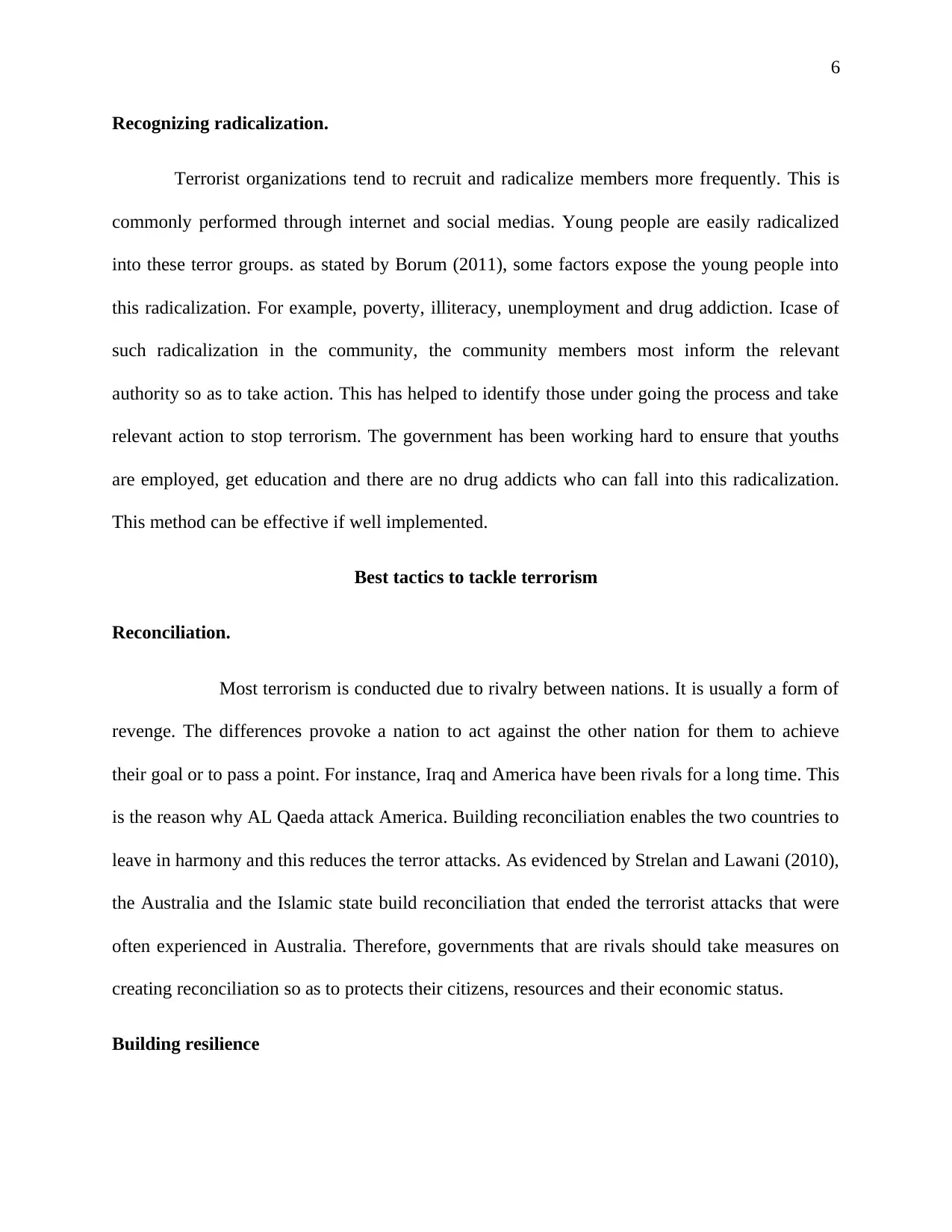
6
Recognizing radicalization.
Terrorist organizations tend to recruit and radicalize members more frequently. This is
commonly performed through internet and social medias. Young people are easily radicalized
into these terror groups. as stated by Borum (2011), some factors expose the young people into
this radicalization. For example, poverty, illiteracy, unemployment and drug addiction. Icase of
such radicalization in the community, the community members most inform the relevant
authority so as to take action. This has helped to identify those under going the process and take
relevant action to stop terrorism. The government has been working hard to ensure that youths
are employed, get education and there are no drug addicts who can fall into this radicalization.
This method can be effective if well implemented.
Best tactics to tackle terrorism
Reconciliation.
Most terrorism is conducted due to rivalry between nations. It is usually a form of
revenge. The differences provoke a nation to act against the other nation for them to achieve
their goal or to pass a point. For instance, Iraq and America have been rivals for a long time. This
is the reason why AL Qaeda attack America. Building reconciliation enables the two countries to
leave in harmony and this reduces the terror attacks. As evidenced by Strelan and Lawani (2010),
the Australia and the Islamic state build reconciliation that ended the terrorist attacks that were
often experienced in Australia. Therefore, governments that are rivals should take measures on
creating reconciliation so as to protects their citizens, resources and their economic status.
Building resilience
Recognizing radicalization.
Terrorist organizations tend to recruit and radicalize members more frequently. This is
commonly performed through internet and social medias. Young people are easily radicalized
into these terror groups. as stated by Borum (2011), some factors expose the young people into
this radicalization. For example, poverty, illiteracy, unemployment and drug addiction. Icase of
such radicalization in the community, the community members most inform the relevant
authority so as to take action. This has helped to identify those under going the process and take
relevant action to stop terrorism. The government has been working hard to ensure that youths
are employed, get education and there are no drug addicts who can fall into this radicalization.
This method can be effective if well implemented.
Best tactics to tackle terrorism
Reconciliation.
Most terrorism is conducted due to rivalry between nations. It is usually a form of
revenge. The differences provoke a nation to act against the other nation for them to achieve
their goal or to pass a point. For instance, Iraq and America have been rivals for a long time. This
is the reason why AL Qaeda attack America. Building reconciliation enables the two countries to
leave in harmony and this reduces the terror attacks. As evidenced by Strelan and Lawani (2010),
the Australia and the Islamic state build reconciliation that ended the terrorist attacks that were
often experienced in Australia. Therefore, governments that are rivals should take measures on
creating reconciliation so as to protects their citizens, resources and their economic status.
Building resilience
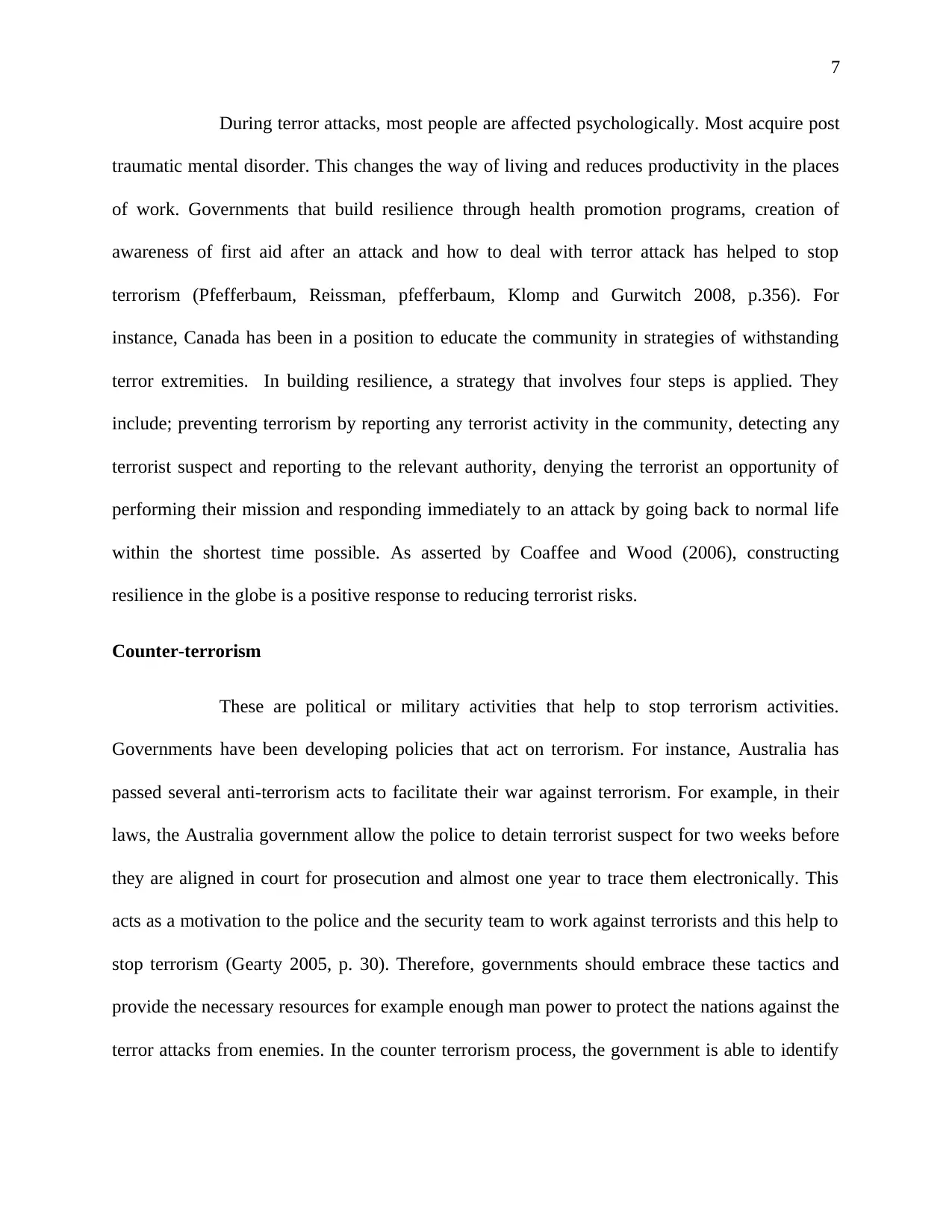
7
During terror attacks, most people are affected psychologically. Most acquire post
traumatic mental disorder. This changes the way of living and reduces productivity in the places
of work. Governments that build resilience through health promotion programs, creation of
awareness of first aid after an attack and how to deal with terror attack has helped to stop
terrorism (Pfefferbaum, Reissman, pfefferbaum, Klomp and Gurwitch 2008, p.356). For
instance, Canada has been in a position to educate the community in strategies of withstanding
terror extremities. In building resilience, a strategy that involves four steps is applied. They
include; preventing terrorism by reporting any terrorist activity in the community, detecting any
terrorist suspect and reporting to the relevant authority, denying the terrorist an opportunity of
performing their mission and responding immediately to an attack by going back to normal life
within the shortest time possible. As asserted by Coaffee and Wood (2006), constructing
resilience in the globe is a positive response to reducing terrorist risks.
Counter-terrorism
These are political or military activities that help to stop terrorism activities.
Governments have been developing policies that act on terrorism. For instance, Australia has
passed several anti-terrorism acts to facilitate their war against terrorism. For example, in their
laws, the Australia government allow the police to detain terrorist suspect for two weeks before
they are aligned in court for prosecution and almost one year to trace them electronically. This
acts as a motivation to the police and the security team to work against terrorists and this help to
stop terrorism (Gearty 2005, p. 30). Therefore, governments should embrace these tactics and
provide the necessary resources for example enough man power to protect the nations against the
terror attacks from enemies. In the counter terrorism process, the government is able to identify
During terror attacks, most people are affected psychologically. Most acquire post
traumatic mental disorder. This changes the way of living and reduces productivity in the places
of work. Governments that build resilience through health promotion programs, creation of
awareness of first aid after an attack and how to deal with terror attack has helped to stop
terrorism (Pfefferbaum, Reissman, pfefferbaum, Klomp and Gurwitch 2008, p.356). For
instance, Canada has been in a position to educate the community in strategies of withstanding
terror extremities. In building resilience, a strategy that involves four steps is applied. They
include; preventing terrorism by reporting any terrorist activity in the community, detecting any
terrorist suspect and reporting to the relevant authority, denying the terrorist an opportunity of
performing their mission and responding immediately to an attack by going back to normal life
within the shortest time possible. As asserted by Coaffee and Wood (2006), constructing
resilience in the globe is a positive response to reducing terrorist risks.
Counter-terrorism
These are political or military activities that help to stop terrorism activities.
Governments have been developing policies that act on terrorism. For instance, Australia has
passed several anti-terrorism acts to facilitate their war against terrorism. For example, in their
laws, the Australia government allow the police to detain terrorist suspect for two weeks before
they are aligned in court for prosecution and almost one year to trace them electronically. This
acts as a motivation to the police and the security team to work against terrorists and this help to
stop terrorism (Gearty 2005, p. 30). Therefore, governments should embrace these tactics and
provide the necessary resources for example enough man power to protect the nations against the
terror attacks from enemies. In the counter terrorism process, the government is able to identify
Paraphrase This Document
Need a fresh take? Get an instant paraphrase of this document with our AI Paraphraser
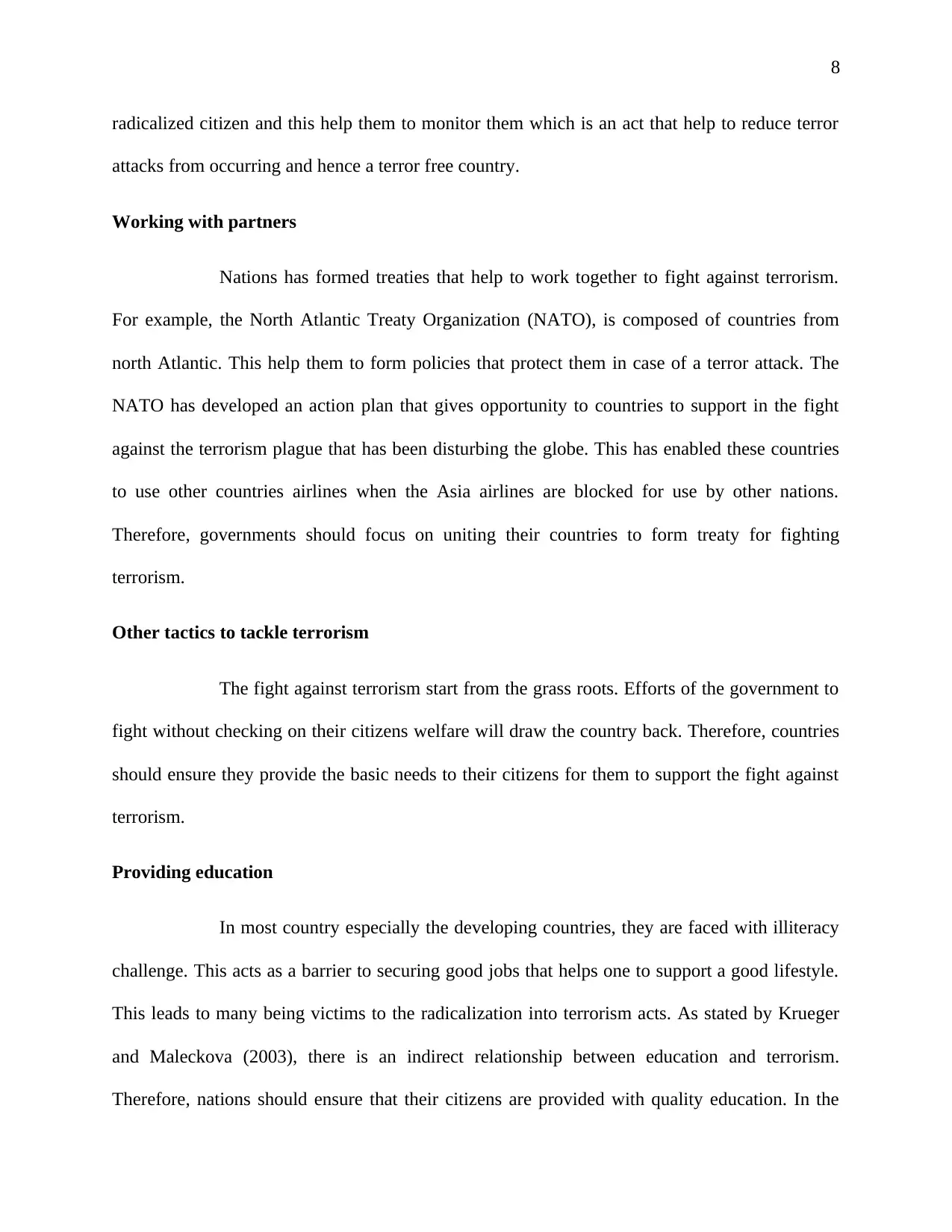
8
radicalized citizen and this help them to monitor them which is an act that help to reduce terror
attacks from occurring and hence a terror free country.
Working with partners
Nations has formed treaties that help to work together to fight against terrorism.
For example, the North Atlantic Treaty Organization (NATO), is composed of countries from
north Atlantic. This help them to form policies that protect them in case of a terror attack. The
NATO has developed an action plan that gives opportunity to countries to support in the fight
against the terrorism plague that has been disturbing the globe. This has enabled these countries
to use other countries airlines when the Asia airlines are blocked for use by other nations.
Therefore, governments should focus on uniting their countries to form treaty for fighting
terrorism.
Other tactics to tackle terrorism
The fight against terrorism start from the grass roots. Efforts of the government to
fight without checking on their citizens welfare will draw the country back. Therefore, countries
should ensure they provide the basic needs to their citizens for them to support the fight against
terrorism.
Providing education
In most country especially the developing countries, they are faced with illiteracy
challenge. This acts as a barrier to securing good jobs that helps one to support a good lifestyle.
This leads to many being victims to the radicalization into terrorism acts. As stated by Krueger
and Maleckova (2003), there is an indirect relationship between education and terrorism.
Therefore, nations should ensure that their citizens are provided with quality education. In the
radicalized citizen and this help them to monitor them which is an act that help to reduce terror
attacks from occurring and hence a terror free country.
Working with partners
Nations has formed treaties that help to work together to fight against terrorism.
For example, the North Atlantic Treaty Organization (NATO), is composed of countries from
north Atlantic. This help them to form policies that protect them in case of a terror attack. The
NATO has developed an action plan that gives opportunity to countries to support in the fight
against the terrorism plague that has been disturbing the globe. This has enabled these countries
to use other countries airlines when the Asia airlines are blocked for use by other nations.
Therefore, governments should focus on uniting their countries to form treaty for fighting
terrorism.
Other tactics to tackle terrorism
The fight against terrorism start from the grass roots. Efforts of the government to
fight without checking on their citizens welfare will draw the country back. Therefore, countries
should ensure they provide the basic needs to their citizens for them to support the fight against
terrorism.
Providing education
In most country especially the developing countries, they are faced with illiteracy
challenge. This acts as a barrier to securing good jobs that helps one to support a good lifestyle.
This leads to many being victims to the radicalization into terrorism acts. As stated by Krueger
and Maleckova (2003), there is an indirect relationship between education and terrorism.
Therefore, nations should ensure that their citizens are provided with quality education. In the
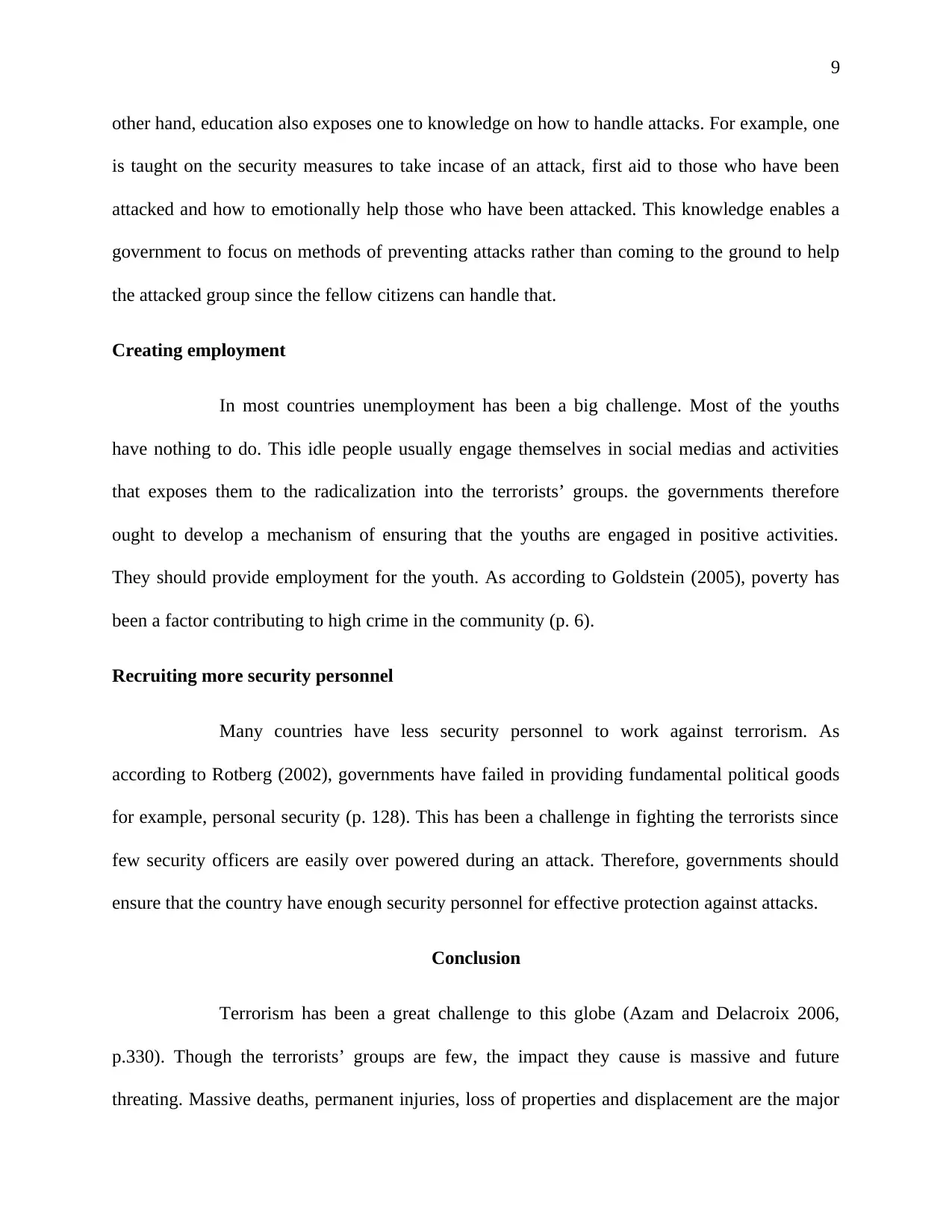
9
other hand, education also exposes one to knowledge on how to handle attacks. For example, one
is taught on the security measures to take incase of an attack, first aid to those who have been
attacked and how to emotionally help those who have been attacked. This knowledge enables a
government to focus on methods of preventing attacks rather than coming to the ground to help
the attacked group since the fellow citizens can handle that.
Creating employment
In most countries unemployment has been a big challenge. Most of the youths
have nothing to do. This idle people usually engage themselves in social medias and activities
that exposes them to the radicalization into the terrorists’ groups. the governments therefore
ought to develop a mechanism of ensuring that the youths are engaged in positive activities.
They should provide employment for the youth. As according to Goldstein (2005), poverty has
been a factor contributing to high crime in the community (p. 6).
Recruiting more security personnel
Many countries have less security personnel to work against terrorism. As
according to Rotberg (2002), governments have failed in providing fundamental political goods
for example, personal security (p. 128). This has been a challenge in fighting the terrorists since
few security officers are easily over powered during an attack. Therefore, governments should
ensure that the country have enough security personnel for effective protection against attacks.
Conclusion
Terrorism has been a great challenge to this globe (Azam and Delacroix 2006,
p.330). Though the terrorists’ groups are few, the impact they cause is massive and future
threating. Massive deaths, permanent injuries, loss of properties and displacement are the major
other hand, education also exposes one to knowledge on how to handle attacks. For example, one
is taught on the security measures to take incase of an attack, first aid to those who have been
attacked and how to emotionally help those who have been attacked. This knowledge enables a
government to focus on methods of preventing attacks rather than coming to the ground to help
the attacked group since the fellow citizens can handle that.
Creating employment
In most countries unemployment has been a big challenge. Most of the youths
have nothing to do. This idle people usually engage themselves in social medias and activities
that exposes them to the radicalization into the terrorists’ groups. the governments therefore
ought to develop a mechanism of ensuring that the youths are engaged in positive activities.
They should provide employment for the youth. As according to Goldstein (2005), poverty has
been a factor contributing to high crime in the community (p. 6).
Recruiting more security personnel
Many countries have less security personnel to work against terrorism. As
according to Rotberg (2002), governments have failed in providing fundamental political goods
for example, personal security (p. 128). This has been a challenge in fighting the terrorists since
few security officers are easily over powered during an attack. Therefore, governments should
ensure that the country have enough security personnel for effective protection against attacks.
Conclusion
Terrorism has been a great challenge to this globe (Azam and Delacroix 2006,
p.330). Though the terrorists’ groups are few, the impact they cause is massive and future
threating. Massive deaths, permanent injuries, loss of properties and displacement are the major
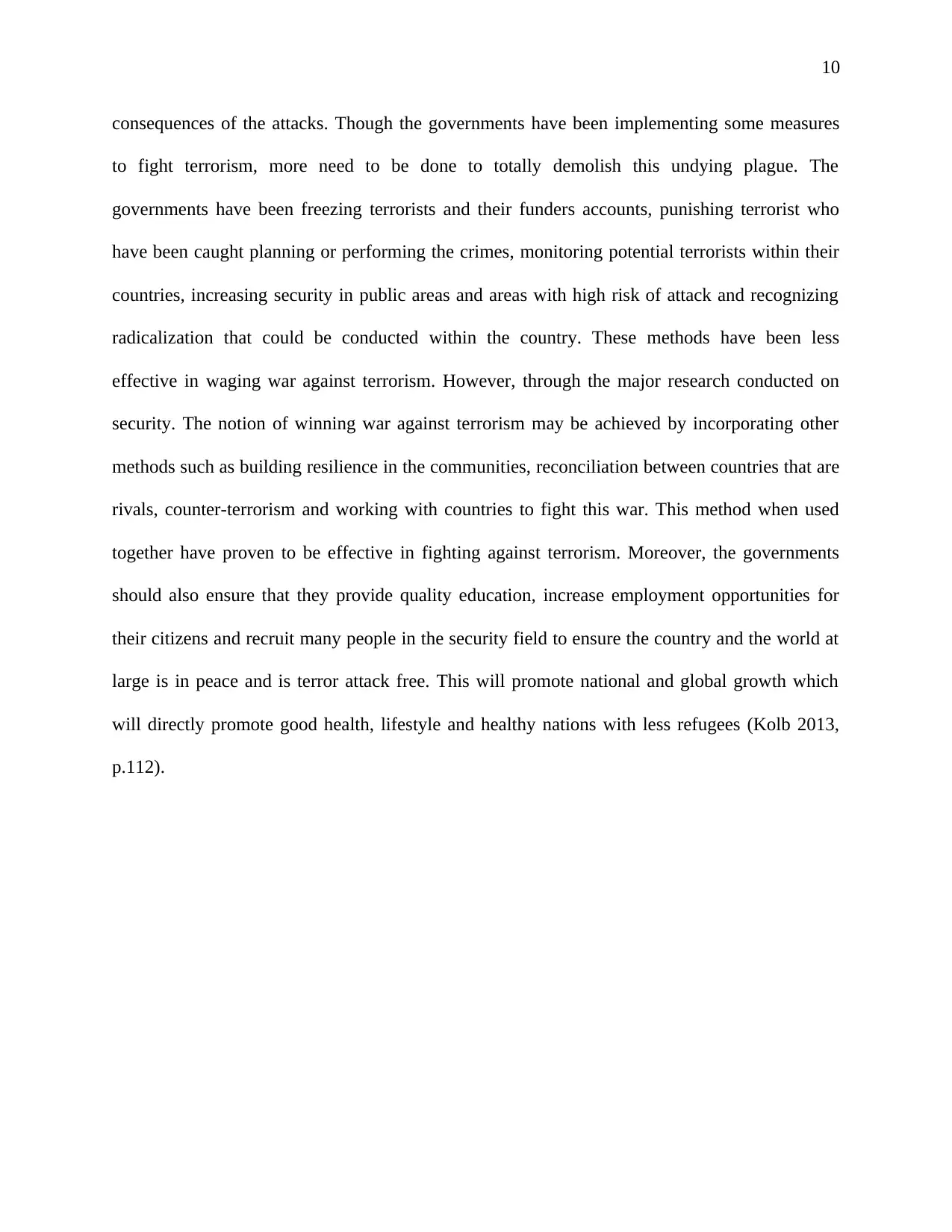
10
consequences of the attacks. Though the governments have been implementing some measures
to fight terrorism, more need to be done to totally demolish this undying plague. The
governments have been freezing terrorists and their funders accounts, punishing terrorist who
have been caught planning or performing the crimes, monitoring potential terrorists within their
countries, increasing security in public areas and areas with high risk of attack and recognizing
radicalization that could be conducted within the country. These methods have been less
effective in waging war against terrorism. However, through the major research conducted on
security. The notion of winning war against terrorism may be achieved by incorporating other
methods such as building resilience in the communities, reconciliation between countries that are
rivals, counter-terrorism and working with countries to fight this war. This method when used
together have proven to be effective in fighting against terrorism. Moreover, the governments
should also ensure that they provide quality education, increase employment opportunities for
their citizens and recruit many people in the security field to ensure the country and the world at
large is in peace and is terror attack free. This will promote national and global growth which
will directly promote good health, lifestyle and healthy nations with less refugees (Kolb 2013,
p.112).
consequences of the attacks. Though the governments have been implementing some measures
to fight terrorism, more need to be done to totally demolish this undying plague. The
governments have been freezing terrorists and their funders accounts, punishing terrorist who
have been caught planning or performing the crimes, monitoring potential terrorists within their
countries, increasing security in public areas and areas with high risk of attack and recognizing
radicalization that could be conducted within the country. These methods have been less
effective in waging war against terrorism. However, through the major research conducted on
security. The notion of winning war against terrorism may be achieved by incorporating other
methods such as building resilience in the communities, reconciliation between countries that are
rivals, counter-terrorism and working with countries to fight this war. This method when used
together have proven to be effective in fighting against terrorism. Moreover, the governments
should also ensure that they provide quality education, increase employment opportunities for
their citizens and recruit many people in the security field to ensure the country and the world at
large is in peace and is terror attack free. This will promote national and global growth which
will directly promote good health, lifestyle and healthy nations with less refugees (Kolb 2013,
p.112).
Secure Best Marks with AI Grader
Need help grading? Try our AI Grader for instant feedback on your assignments.
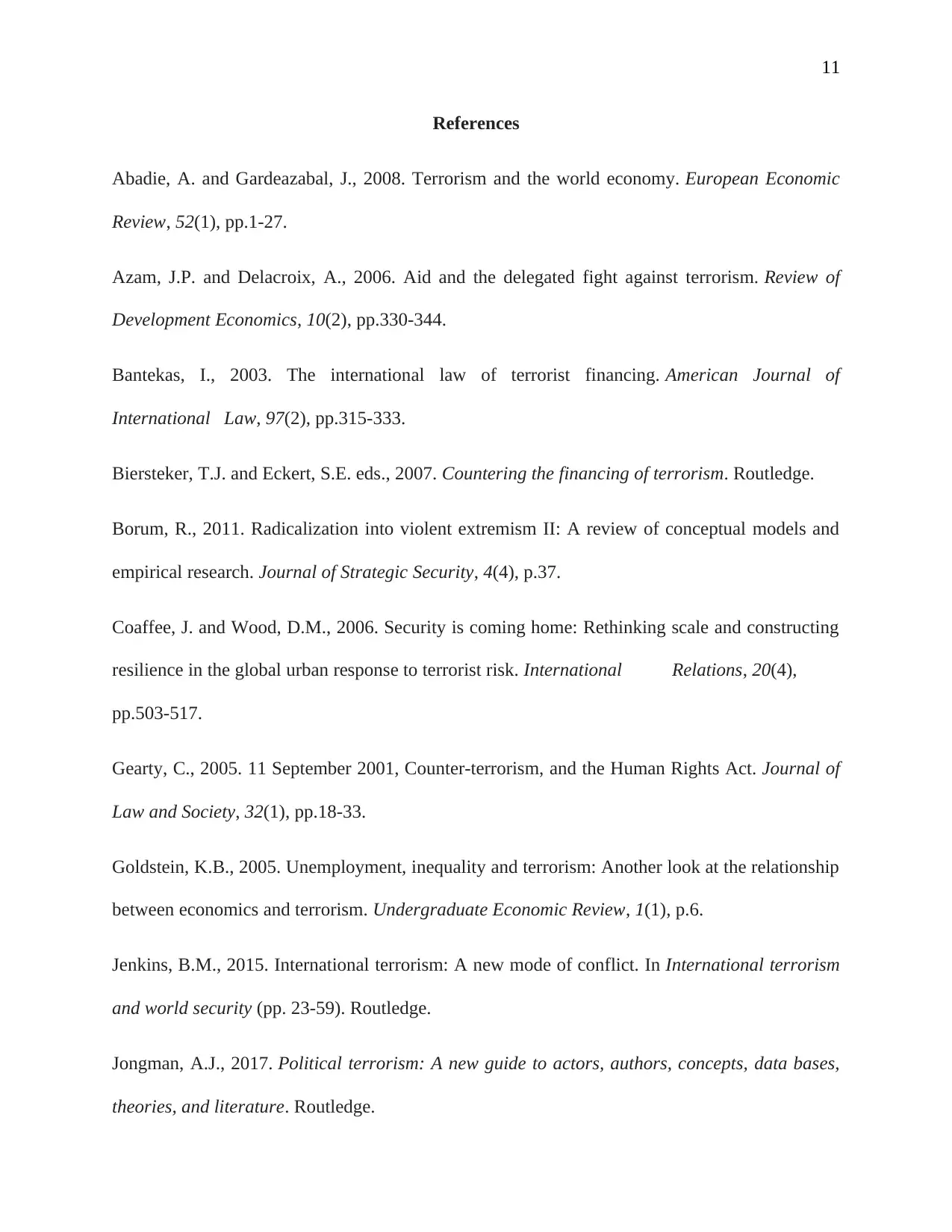
11
References
Abadie, A. and Gardeazabal, J., 2008. Terrorism and the world economy. European Economic
Review, 52(1), pp.1-27.
Azam, J.P. and Delacroix, A., 2006. Aid and the delegated fight against terrorism. Review of
Development Economics, 10(2), pp.330-344.
Bantekas, I., 2003. The international law of terrorist financing. American Journal of
International Law, 97(2), pp.315-333.
Biersteker, T.J. and Eckert, S.E. eds., 2007. Countering the financing of terrorism. Routledge.
Borum, R., 2011. Radicalization into violent extremism II: A review of conceptual models and
empirical research. Journal of Strategic Security, 4(4), p.37.
Coaffee, J. and Wood, D.M., 2006. Security is coming home: Rethinking scale and constructing
resilience in the global urban response to terrorist risk. International Relations, 20(4),
pp.503-517.
Gearty, C., 2005. 11 September 2001, Counter‐terrorism, and the Human Rights Act. Journal of
Law and Society, 32(1), pp.18-33.
Goldstein, K.B., 2005. Unemployment, inequality and terrorism: Another look at the relationship
between economics and terrorism. Undergraduate Economic Review, 1(1), p.6.
Jenkins, B.M., 2015. International terrorism: A new mode of conflict. In International terrorism
and world security (pp. 23-59). Routledge.
Jongman, A.J., 2017. Political terrorism: A new guide to actors, authors, concepts, data bases,
theories, and literature. Routledge.
References
Abadie, A. and Gardeazabal, J., 2008. Terrorism and the world economy. European Economic
Review, 52(1), pp.1-27.
Azam, J.P. and Delacroix, A., 2006. Aid and the delegated fight against terrorism. Review of
Development Economics, 10(2), pp.330-344.
Bantekas, I., 2003. The international law of terrorist financing. American Journal of
International Law, 97(2), pp.315-333.
Biersteker, T.J. and Eckert, S.E. eds., 2007. Countering the financing of terrorism. Routledge.
Borum, R., 2011. Radicalization into violent extremism II: A review of conceptual models and
empirical research. Journal of Strategic Security, 4(4), p.37.
Coaffee, J. and Wood, D.M., 2006. Security is coming home: Rethinking scale and constructing
resilience in the global urban response to terrorist risk. International Relations, 20(4),
pp.503-517.
Gearty, C., 2005. 11 September 2001, Counter‐terrorism, and the Human Rights Act. Journal of
Law and Society, 32(1), pp.18-33.
Goldstein, K.B., 2005. Unemployment, inequality and terrorism: Another look at the relationship
between economics and terrorism. Undergraduate Economic Review, 1(1), p.6.
Jenkins, B.M., 2015. International terrorism: A new mode of conflict. In International terrorism
and world security (pp. 23-59). Routledge.
Jongman, A.J., 2017. Political terrorism: A new guide to actors, authors, concepts, data bases,
theories, and literature. Routledge.
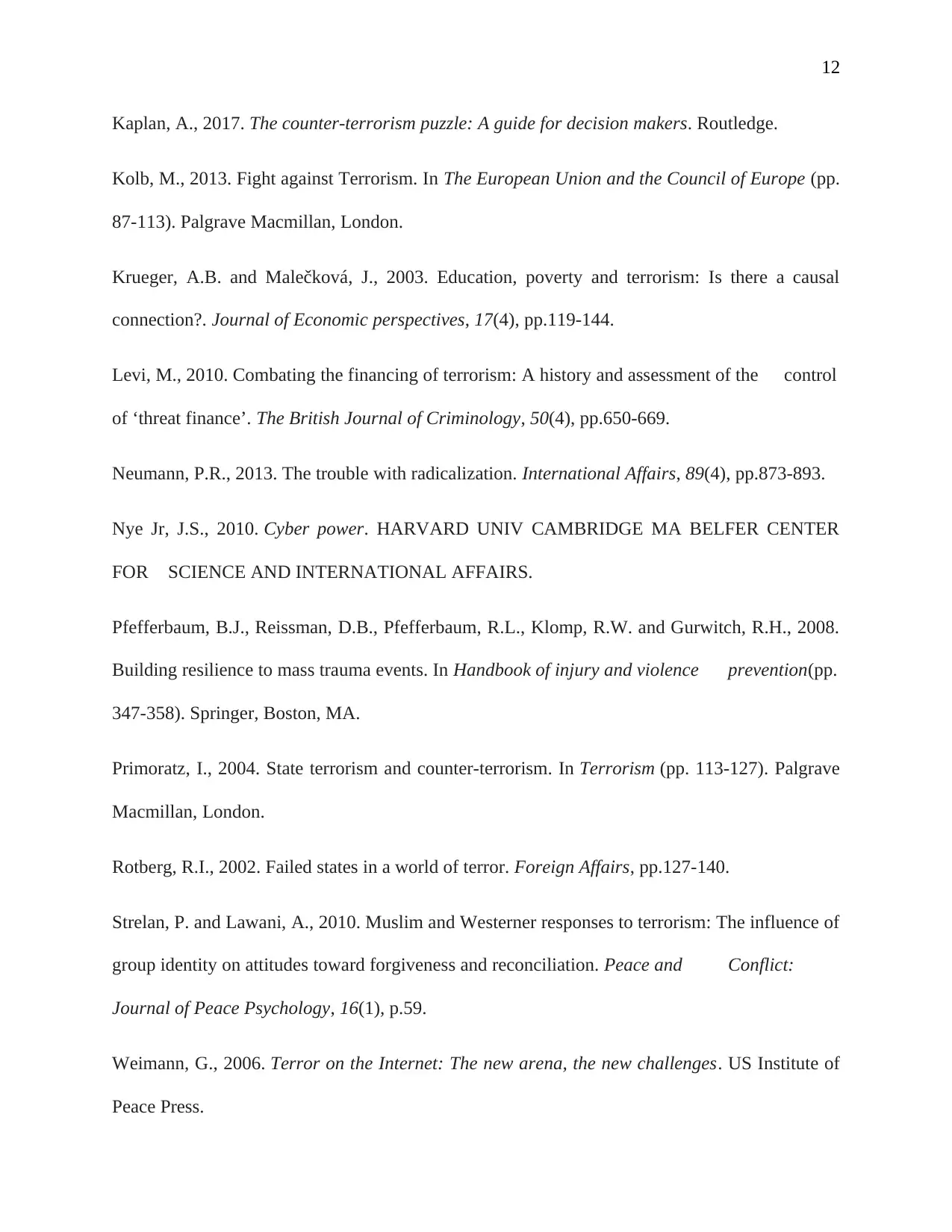
12
Kaplan, A., 2017. The counter-terrorism puzzle: A guide for decision makers. Routledge.
Kolb, M., 2013. Fight against Terrorism. In The European Union and the Council of Europe (pp.
87-113). Palgrave Macmillan, London.
Krueger, A.B. and Malečková, J., 2003. Education, poverty and terrorism: Is there a causal
connection?. Journal of Economic perspectives, 17(4), pp.119-144.
Levi, M., 2010. Combating the financing of terrorism: A history and assessment of the control
of ‘threat finance’. The British Journal of Criminology, 50(4), pp.650-669.
Neumann, P.R., 2013. The trouble with radicalization. International Affairs, 89(4), pp.873-893.
Nye Jr, J.S., 2010. Cyber power. HARVARD UNIV CAMBRIDGE MA BELFER CENTER
FOR SCIENCE AND INTERNATIONAL AFFAIRS.
Pfefferbaum, B.J., Reissman, D.B., Pfefferbaum, R.L., Klomp, R.W. and Gurwitch, R.H., 2008.
Building resilience to mass trauma events. In Handbook of injury and violence prevention(pp.
347-358). Springer, Boston, MA.
Primoratz, I., 2004. State terrorism and counter-terrorism. In Terrorism (pp. 113-127). Palgrave
Macmillan, London.
Rotberg, R.I., 2002. Failed states in a world of terror. Foreign Affairs, pp.127-140.
Strelan, P. and Lawani, A., 2010. Muslim and Westerner responses to terrorism: The influence of
group identity on attitudes toward forgiveness and reconciliation. Peace and Conflict:
Journal of Peace Psychology, 16(1), p.59.
Weimann, G., 2006. Terror on the Internet: The new arena, the new challenges. US Institute of
Peace Press.
Kaplan, A., 2017. The counter-terrorism puzzle: A guide for decision makers. Routledge.
Kolb, M., 2013. Fight against Terrorism. In The European Union and the Council of Europe (pp.
87-113). Palgrave Macmillan, London.
Krueger, A.B. and Malečková, J., 2003. Education, poverty and terrorism: Is there a causal
connection?. Journal of Economic perspectives, 17(4), pp.119-144.
Levi, M., 2010. Combating the financing of terrorism: A history and assessment of the control
of ‘threat finance’. The British Journal of Criminology, 50(4), pp.650-669.
Neumann, P.R., 2013. The trouble with radicalization. International Affairs, 89(4), pp.873-893.
Nye Jr, J.S., 2010. Cyber power. HARVARD UNIV CAMBRIDGE MA BELFER CENTER
FOR SCIENCE AND INTERNATIONAL AFFAIRS.
Pfefferbaum, B.J., Reissman, D.B., Pfefferbaum, R.L., Klomp, R.W. and Gurwitch, R.H., 2008.
Building resilience to mass trauma events. In Handbook of injury and violence prevention(pp.
347-358). Springer, Boston, MA.
Primoratz, I., 2004. State terrorism and counter-terrorism. In Terrorism (pp. 113-127). Palgrave
Macmillan, London.
Rotberg, R.I., 2002. Failed states in a world of terror. Foreign Affairs, pp.127-140.
Strelan, P. and Lawani, A., 2010. Muslim and Westerner responses to terrorism: The influence of
group identity on attitudes toward forgiveness and reconciliation. Peace and Conflict:
Journal of Peace Psychology, 16(1), p.59.
Weimann, G., 2006. Terror on the Internet: The new arena, the new challenges. US Institute of
Peace Press.
1 out of 12
Related Documents
Your All-in-One AI-Powered Toolkit for Academic Success.
+13062052269
info@desklib.com
Available 24*7 on WhatsApp / Email
![[object Object]](/_next/static/media/star-bottom.7253800d.svg)
Unlock your academic potential
© 2024 | Zucol Services PVT LTD | All rights reserved.




